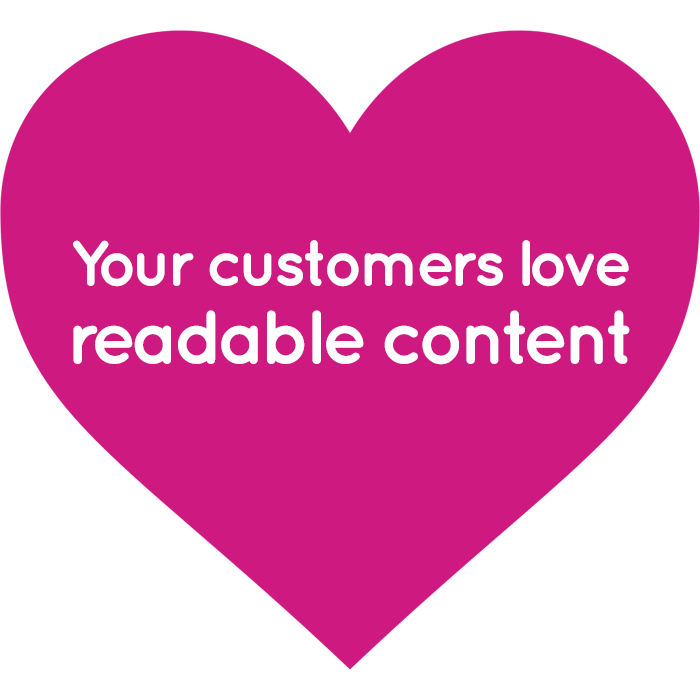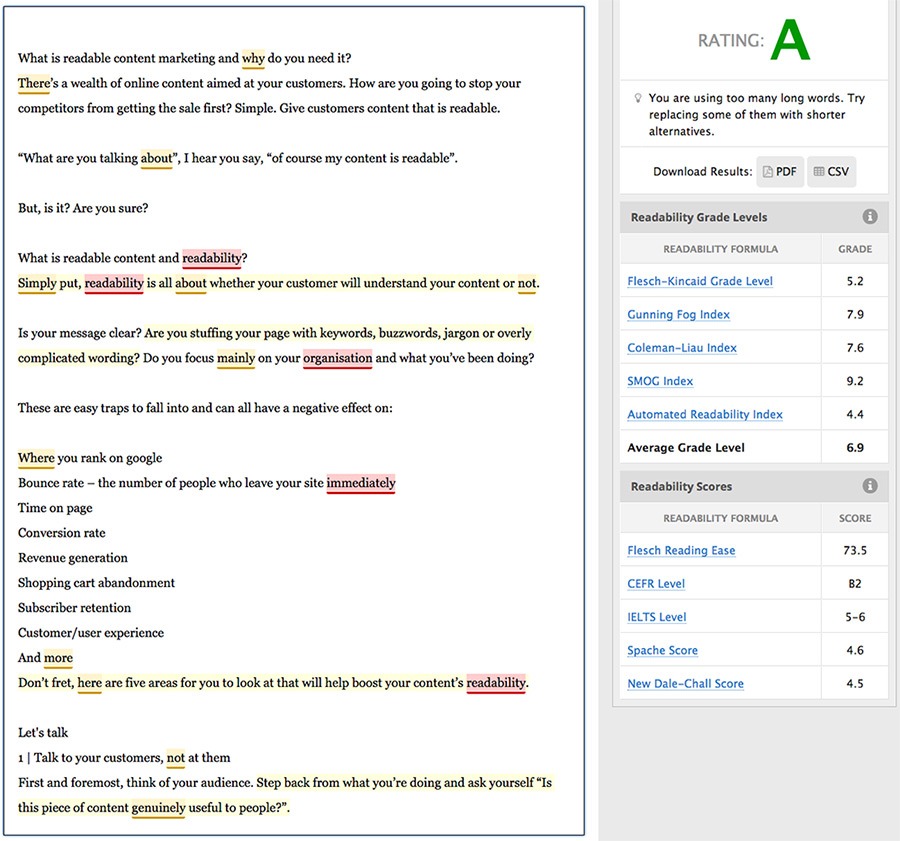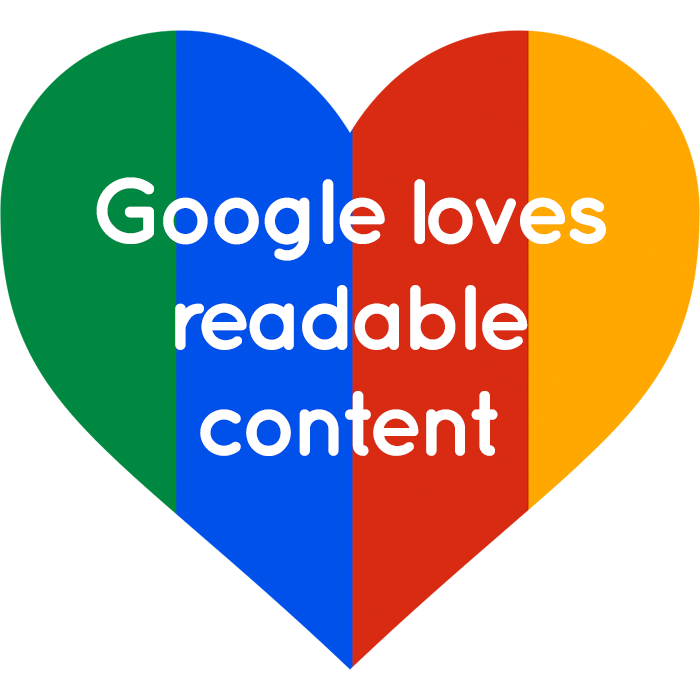There’s a wealth of online content aimed at your customers. How are you going to stop your competitors from getting the sale first? Simple. Give customers readable content.
“What are you talking about,” I hear you say, “of course my content is readable.”
But, is it? Are you sure?
What is readable content and readability?
Simply put, readability is all about whether your customer will understand your content or not.
Is your message clear? Are you stuffing your page with keywords, buzzwords, jargon, or overly complicated wording? Do you focus mainly on your organization and what you’ve been doing?
These are easy traps to fall into and can all have a negative effect on:
- Where you rank on google
- Bounce rate - the number of people who leave your site immediately
- Time on page
- Conversion rate
- Revenue generation
- Shopping cart abandonment
- Subscriber retention
- Customer/user experience
- And more
Don’t fret, here are five areas for you to look at that will help boost your content’s readability.
1 | Talk to your customers, not at them
First and foremost, think of your audience. Step back from what you're doing and ask yourself, “Is this piece of content genuinely useful to people?”.
It’s easy to be so wrapped up in what you are doing that you fall into the “me, me, me” trap.
Talking about yourself, your product features, or the latest award you’ve won is easy to do. Talking to your customers in a way that focuses on them, not so much.
Your content is very forgettable if you don’t bring the focus back to your customer. What are the great benefits your organization can provide to them?
“When people talk to themselves it’s called insanity; when companies talk to themselves, it’s called marketing.” — Steve Bautista
Stick to clear messaging that is easy to understand and focuses on customer benefits.
When you do this, customers can easily see why they need your brand or product in their life.

2 | Online customers love readable content
When I read blogs aimed at marketers, like this one, I’m tempted to set up a Stating the obvious award for content marketing.
Here’s my entry - the internet has changed the way we read.
Now I have to back that bleedingly obvious statement up with a cool bit of context. Here goes…
The internet has changed the way we read, but it hasn’t changed the way a lot of people write.
As content producers, we can still fall foul of:
- Too much information
- Long-winded sentences
- Even longer winded paragraphs
- Writing in a convoluted manner, so to appear like you're an expert
- Etc, etc
I’ve been massively guilty of this in the past. When running the marketing for a former employer - an online training provider - I’d cram in too much information.
You’d open an email from me to find it stuffed full of course titles. Including every project management or IT course we provided. Best to pack a sandwich before reading...
Through vigorous A/B testing, and maturing as a copywriter, I learned that people don’t need to know everything. Certainly not at the email level.
What they need to know from an email is:
- What are you offering?
- What’s in it for me?
- Why should I trust you?
Subject lines changed from Free MS Project + Prince2 with every PMP or CAPM course to Earn over £50k as a senior project manager.
Readers could now easily see what was in it for them. Open rate, click-through and conversion rate went through the roof.
As you move people along your marketing funnel. Give them more and more access to information. But, don’t expect them to want, or need, to read it.
Terms and conditions are a great example of this. I’ll talk about that in a section or two.
Related post: Have you read the terms and conditions? The readability of insurance policies.
The same advice stands for landing pages, blogs, product overviews and every other page. Keep it simple.
Some rules that I stick by:
- Short sentences and paragraphs - avoid a wall of text
- Bullet points. People like to skim a page and bullet points make that easier
- It’s all about outcomes.
- What’s in it for the reader?
- Will a reader find this genuinely useful?
- How can your product or service benefit the reader?
- Fear of missing out
- Get out the red pen. That’s more of a symbolic statement these days, but I edit, edit and then edit some more
- Run everything through Readable
- Leave it a day or two before posting
The last tip is one I’ve brought over from my attempts at producing house music. But, it’s true for content marketing too.
When you’ve just created something, you think it’s the business. Bang on the money. Going back to it after a few hours or days gives perspective.
It’ll make you realize you shouldn’t have had that extra beer when working on your new tune. Not quite the club stomper you thought it was, is it Stephen?
There are whole sections of this blog that I thought was great that are now happily deleted...
3 | Google loves that your visitors love your readable content
Ah, the mystical beings that are Google’s search algorithms… If only you’d share with us your secretive ways…
One thing is for sure, Google loves that your readers love readable content. It ticks many of the SEO boxes you need to be hitting:
- Decreases bounce rate
- Increases time on site
- Content delivers for the reader
- Readers want to share that content
- Readers go further into your site
- They also
- Click on call to actions
- Add products to their shopping carts
- Spend money with you
- Keep on coming back
I got excited just typing that...
Use readability as an SEO tool but, first and foremost, use it as a customer experience tool.
4 | Readable terms and conditions that don’t confuse
Don’t you just love reading terms and conditions? Wait a minute, you don’t? A survey from Deloitte found you’re not alone. Over 90% of people feel the same way.
Similarly, the Guardian reported that 543 students signed up for NameDrop, a new social network. All happy to click 'accept terms'.
Thankfully, NameDrop wasn’t real. As all had agreed to give NameDrop their first born child.
Only a quarter bothered to look at the terms. Crucially, look and read are two very different things. Meaning nobody bothered to read them.
That’s a lot of people not fully understanding what they’re signing up for.
Nobody has yet fallen foul as badly as Kyle in South Park’s HumancentiPad episode. But, we do have a moral and, now thanks to GDPR, a legal obligation to make terms and conditions readable.
This is not always easy and its something we have to work on too. We do this by adding plain language notes to our own terms and conditions.
You can also easily do this.
5 | ReadablePro, a fantastic SEO tool for creating readable content
Over the last 50 years, a number of highly effective readability scoring algorithms have been developed. All with their unique take on what readability means.
To make the writing process straightforward, we created Readable. A content and SEO tool that pulls together all of the major readability algorithms. Including Flesch-Kincaid, Gunning Fog and the SMOG index.
Each of the readability scores gives content a grade level, based on the US education system. The average reader will be between grade levels 7 and 8 - roughly the same as a high school leaver.
To enable you to clearly see how your content scores, we produce an average grade level for your copy.
To make it even clearer, we’ve taken this one step further and developed our own unique readability score of A, B, C, D or E. This is aggregated from each of the major algorithms.
Our readability algorithm will show you:
- The reading level your content scores at
- Where you need to refine your content
- Analytics and text statistics - letter, word and syllable counts
- Composition stats - adjective, noun and adverb counts
- Keyword densities - single words and two or three-word phrases
- Reading and speaking time
- Sentiment analysis - is the text positive, negative or neutral?
With your content, aim for A or B overall and an average grade level of 7 or 8.
This blog scores an A with a grade level of 6.9. I’ll happily take that. It means the vast majority of people reading this will understand it. Just what I wanted.
Note - my first draft scored a B with a grade level of 10.

As you can see, there are still areas where I can improve my readability. But, you don’t need to sacrifice your voice or writing style to make things perfectly readable. Perfection is the enemy of progress.

Now, we have our own challenge at Readable as the word ‘readability’ scores badly for readability. Talk about ironic… and this blog is full of it.
There are always going to be words that are unique to your brand that have to be included. For us, it just happens to be readability. For one of our users, it’s psychology. But, that’s OK.
By sticking to good readability practices with the rest of your content, your work will turn out just fine.
How our readability algorithms work deserved a blog for each of them. We’ve got some great further reading for you:
- The Flesch Reading Ease and Flesch-Kincaid Grade Level
- The Gunning Fog Index
- How to choose the right readability formula
- The Coleman-Liau Index
- What are reading level calculators?
- How CEFR can boost your content marketing
How does your content score?
You can test your text for free today at readable.com/text. We’d love to hear what your score is.
To sum up, keep it simple. Think of your customer first, understand what they would like from your content and then go to work.
sources: The Guardian. Deloitte.




